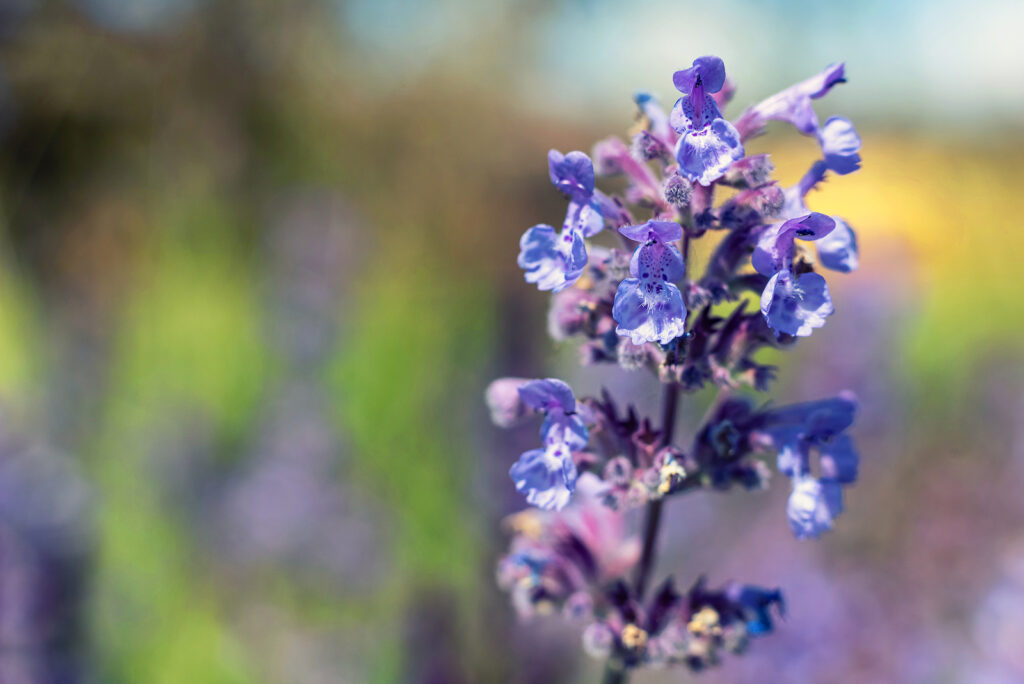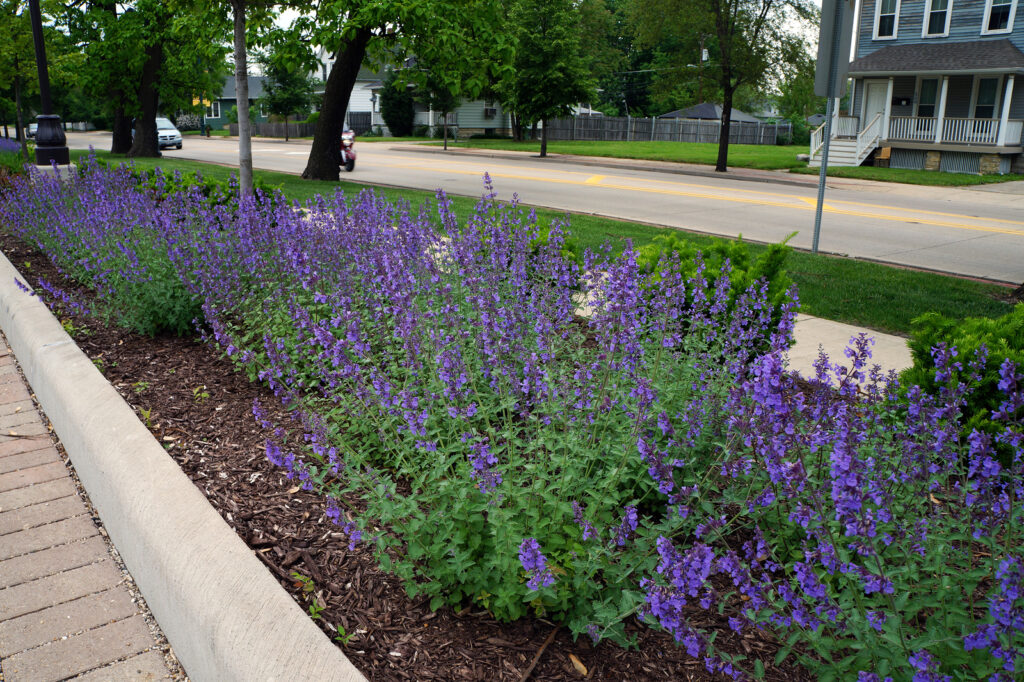Nepeta, also known as catnip or catmint, is a hardy perennial plant that is relatively easy to grow.
Nepeta is a perennial herb that belongs to the mint family, Lamiaceae. It is a bushy plant with gray-green leaves that have a pungent aroma when crushed. Nepeta produces small, lavender-blue flowers that bloom in spikes during the summer months.
Nepeta can be grown as an attractive informal low hedge or as a border or bed edgling. It is known for its ability to attract cats. Cats are attracted to the scent of nepetalactone, a volatile compound found in the leaves and stems of Nepeta. When cats come into contact with catnip, they often exhibit playful and excited behavior.
Nepeta is prized for its ornamental value in gardens and landscapes. It is a low-maintenance plant that thrives in sunny locations with well-drained soil. It also has herbal uses; it has been traditionally used for its calming and sedative properties in humans.

Get to know Catmint – Nepeta
- Plant type: Perennial
- Growing zones and range: Zones 3-9 depending on species
- Hardiness: Dies back to the ground after freezing temperatures
- Height and width: 18 to 24 inches tall and white
- Foliage: Aromatic gray-green leaves, square stems
- Flowers: Spikes of small two-lipped flowers, primarily in shades of lavender, purple, violet, and white
- Bloom time: Summer
- Uses: Herb garden, flower garden
- Common name: Catmint, catnip
- Botanical name: Nepeta
- Family name: Lamiaceae
- Origin: Europe, Caucasus, Himalaya
Where to plant catmint – Nepeta
- Nepeta thrives in full sun to partial shade. Choose a spot in the garden that receives at least 6 hours of sunlight per day.
- Nepeta prefers well-draining soil that is rich in organic matter. Amend heavy or clay-like soil with compost, aged manure, or peat moss to improve drainage.
- Nepeta can thrive in drier areas once established.
- In very hot summer regions, plant Nepeta where it can get some mid-day shade. Nepeta nervosa is the most heat-tolerant.
When to plant catmint – Nepeta
- Plant Nepeta in the spring or fall. Plant nepeta in the spring after the last frost date in your area.

Planting and spacing catmint – Nepeta
- Nepeta can be grown from seed, but it is easier to start with young plants purchased from a nursery.
- Dig a hole slightly larger than the root ball of the plant and place it in the hole at the same level it was planted in its container. Water the plant thoroughly after planting.
- Space Nepeta about 18 to 24 inches apart.
How to water and feed catmint – Nepeta
- Water Nepeta regularly, especially during dry spells, to keep the soil evenly moist. Water Nepeta when the top inch of soil feels dry to the touch. Be careful not to overwater as this can lead to root rot.
- Nepeta is drought-tolerant once established, but it still needs regular watering, especially during dry periods. Water the plant deeply once a week, rather than shallow watering more frequently.
- Nepeta is a low-maintenance plant that generally does not require much fertilizing. If your soil is poor, you can apply a balanced fertilizer in the spring to promote healthy growth. Avoid over-fertilizing as it can lead to leggy growth.
Catmint – Nepeta care
- Trim back Nepeta plants after they have finished blooming to encourage fresh growth and prevent them from becoming woody or leggy. This will also help to prolong the flowering period.
- To encourage bushier growth and more blooms, prune nepeta back by about half in early summer after the first flush of blooms has faded. Cut back the plant by half to a third, and it will bloom again in a few weeks.
- Taller-growing catmints may need staking, but they are also attractive when allowed to flop.
- Mulch around the base of Nepeta to help retain moisture and suppress weeds. This can also help keep the plant’s roots cool during hot summer months.
Catmint – Nepeta pests and diseases
- Nepeta is generally pest and disease-resistant, but you may encounter some issues like aphids or powdery mildew. To control pests, you can use insecticidal soap, and for powdery mildew, make sure the plant has good air circulation.
- Nepeta is relatively pest and disease-resistant, but it may attract cats due to its odor. To deter cats, you can plant Nepeta in a protected area or use a physical barrier around the plant.
Catmint – Nepeta propagation
- Nepeta can be easily propagated by division in the spring or fall. Simply dig up a clump of the plant, separate it into smaller sections, and replant them in a new location.
- Nepeta can be propagated by cuttings taken in summer. Root the cuttings in water or soil.
- Nepeta cataria can be grown from seed; it easily self-sows if not deadheaded.

Catmint – Nepeta varieties to grow
- Nepeta cataria, commonly called catnip; grows to 3 feet tall with aromatic gray-green woolly leaves; bears small wite flowers spotted with purple in summer.
- N. x faassenii, commonly called catmint: grow 12 to 24 inches tall and 18 inches wide; aromatic, hairy, silvery gray-green leaves; bears spikes of lavender-blue flowers from early summer to fall. Cultivars include ‘Snowflake’ and ‘White Wonder’ with white flowers; ‘Dropmore’ is larger to 2 feet tall; ‘Six Hills Giant’ grows to 3 feet tall and bears showy spiked of violet-purple flowers.
- N. govaniana, yellow catmint; grows to 3 feet tall and bears large loose racemes of paly yellow flowers from midsummer to fall.
- N. nervosa, commonly called veined Nepeta, is a mounding plant to 2 feet tall with mildly aromatic gray-green leaves; bears dense racemes of purple-blue flowers.
- N. siberica, called Siberian catnipo, grows to 3 feet tall with lance-shaped leaves and bears racemes of lavender-blue flowers in summer.















